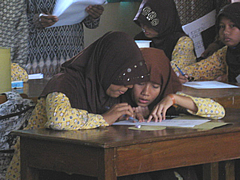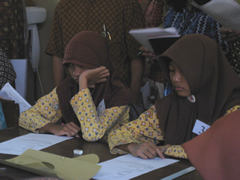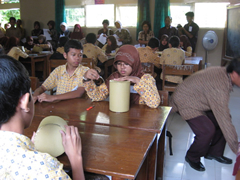- Home
- Technical Cooperation Projects
- Index of Countries
- Asia
- Indonesia
- Program for Enhancing Quality of Junior Secondary Education
- Project News
- LS Reference Sites in Java : The 6th MGMP Facilitator Training
Project News
2010-08-31
LS Reference Sites in Java : The 6th MGMP Facilitator Training
 Students collaborating to solve the problem together.
Students collaborating to solve the problem together.
The 6th MGMP Facilitator Training was conducted in Sumedang, District, Bantul District, and Pasuruan District in August. For facilitators to experience the LS cycle of improving the lesson through reflection and plan, open classes in this training were done with the same model teacher, the same contents and with different students in all 3 districts. Let's take a close look at the lessons in Bantul. What has been improved from Day1 and Day2, and what problems did each lesson have?
In Bantul, the class was well prepared as the model teacher prepared power point slides and paper-made tube models for the open class. However, in the first day class, students did not have a chance to utilize the tube model because the teacher showed the development of a tube in the power point, and explained that the length of circumference of the base circle and top circle and the length of the horizontal line of the side are the same. Thus, there was nothing that students could explore by themselves, and there was no expression in students. Another problem was that the explanation on how to factorize the equation to get to the formula was not enough. Many students did not understand the meaning of the formula and just put the numbers into the formula to get the answer without understanding what they were doing. These problems were pointed out by other facilitators (teachers) who observed the lesson in the reflection. In Bantul, there are some teachers who can grasp the essence of the issues in a lesson, but still, it is not easy to plan a lesson, discussing exactly what part of the lesson need to be changed and how it should be changed to solve the problems pointed out in the reflection. Thus, in the plan session at the end of Day1 JICA Experts and mathematics teachers together examined how to improve the second day class in detail. They examined the lesson flow, what should be the objective and activities in each part of the lesson, what kind of exercise should be given to students for each activity, whether the activity to be done by individual or in group, and how to interact with students.
 Students lost interest in the lesson and cannot concentrate.
Students lost interest in the lesson and cannot concentrate.
On Day2, teacher introduced the activity to develop the paper-made tube model by each group and questions on the work sheet were improved by reflecting the advice in the plan session. However, as there was no interaction (class talk) among the teacher and students before students actually developed the model, such as "how many shapes can you find?", "what shape are they?", and "which length do you need to know to calculate surface area?", students did not understand the reason why they needed to develop the model. Accordingly, there was no exploration by students. In the reflection, JICA Experts advised how to utilize class talk. Also, JICA Experts pointed out that presentation on exercise answers took too much time, and that led to the shortage of the time for more important things such as explanation on how to get the formula and exercise by utilizing the formula.
 Student trying to develop a paper-made tube.
Student trying to develop a paper-made tube.
Teachers were surprised that they had to plan in very detail, taking almost 2 hours, in the Day1 plan session. JICA Experts will continuously tell the teachers that plan session can not be meaningful until it is planned thoroughly as they did in this training.
- About JICA
- News & Features
- Countries & Regions
- Our Work
- Thematic Issues
- Types of Assistance
- Partnerships with Other Development Partners
- Climate Change / Environmental and Social Considerations
- Evaluations
- Compliance and Anti-corruption
- Science and Technology Cooperation on Global Issues
- Research
- JICA Development Studies Program / JICA Chair
- Support for the Acceptance of Foreign HRs / Multicultural and Inclusive Community
- Publications
- Investor Relations
